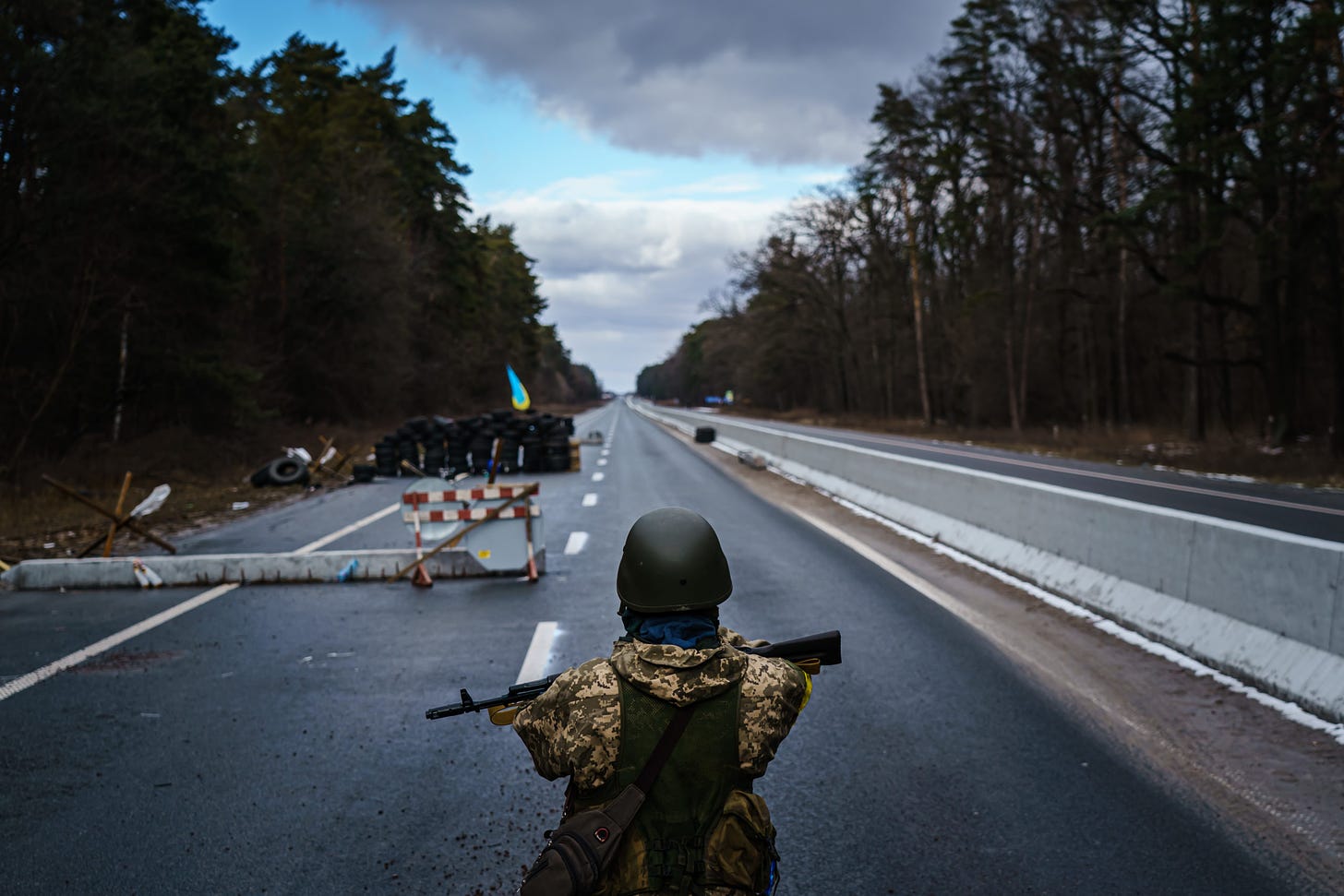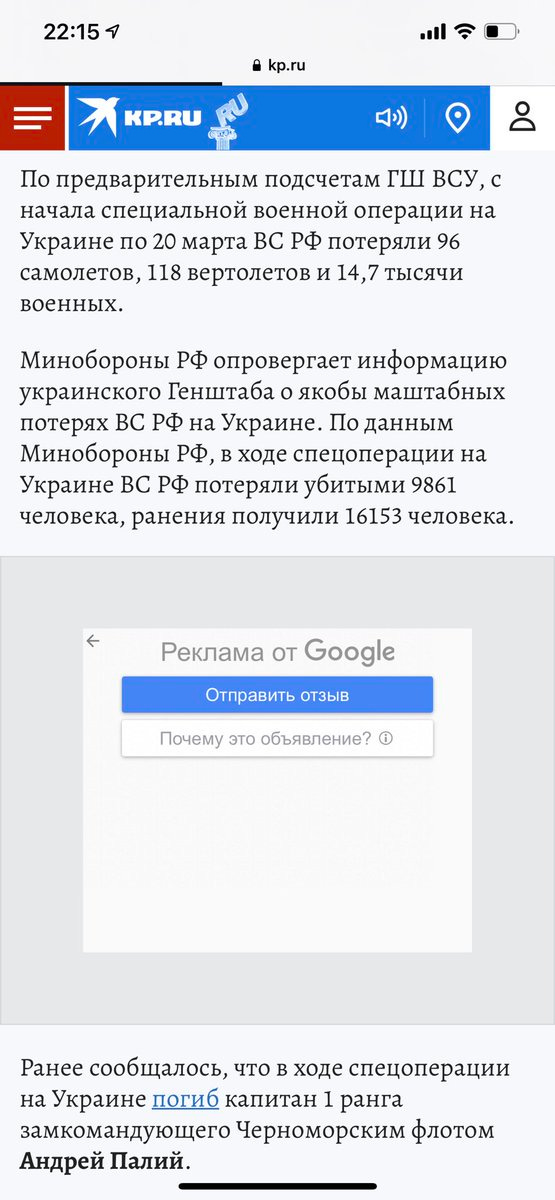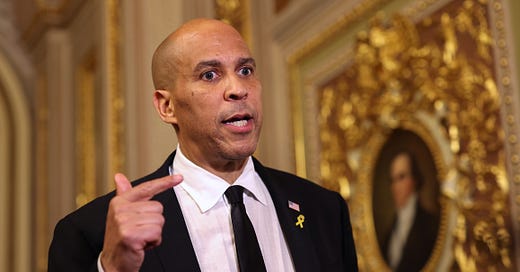
No Certainties in Ukraine Outcome
Western observers shouldn’t get their hopes up—but neither should they despair.

In 2003, years before General David Petraeus rescued Americans and Iraqis from civil war and a terrorist-driven insurgency in Iraq, he famously said to military historian Rick Atkinson, “Tell me how this ends.” Not even Petraeus knew in advance how that miserable conflict would end, and he had more of a say in how it finally did than almost anyone.
Petraeus doesn’t know how the Russia-Ukraine War will end either—and neither do I, and neither do you. Yet no shortage of people in Western media and especially on social media have already made up their minds that one side or the other is bound to prevail, with their moods ranging from elation and schadenfreude to despondency.
Hardly anything in this world is as unpredictable as war. Projecting the outcome isn’t rocket surgery—it’s harder. We can’t plot trend lines on a graph the way epidemiologists can forecast COVID-19 surges or meteorologists can predict rising temperatures as winter gives way to spring. The beginning of a new war, as a notorious German tyrant once put it, is like “pushing open the door to a dark room, never seen before, without knowing what lies behind the door.”
We have a good idea how Vladimir Putin (along with plenty of Westerners, including yours truly) initially thought the invasion would end—with a Russian blitzkrieg that decapitates Ukraine’s government and installs a puppet regime in Kiev while a fragmented West bickers over how many puny sanctions to impose.
That’s off the table.
Nearly a month in, Kiev is still Ukraine’s sovereign capital, President Volodymyr Zelensky is keeping the lights on and the arms flowing, the invasion has stalled, demoralized Russian soldiers are surrendering, and videos of destroyed Russian armored columns are released almost daily. Many of the most salient images of the war so far is of Ukrainian tractors towing abandoned Russian tanks off the road.
Germany has pledged to nearly double its defense spending, Finland and Sweden are seriously considering NATO membership, and the most punishing sanctions in the history of the world have triggered an economic meltdown in Russia on par with that of reactor number four at Chernobyl. In early March, Western nations supplied Ukraine with 17,000 anti-tank weapons in six days. Even famously neutral Switzerland has gotten in on the action.
According to U.S. intelligence estimates, which have tended to be conservative, Russia has lost more soldiers in Ukraine in less than a month than the United States lost in Iraq and Afghanistan combined in twenty years. That makes Russia’s Ukraine adventure more than 200 times deadlier per day. Figures purportedly from the Russian defense ministry—published yesterday on the website of a Russian newspaper before being quickly deleted—indicate very high casualty rates:


Even so, we can’t know how the war in Ukraine will end any more than Petraeus in 2003 could know how the Iraq war would end. There’s a range of possible outcomes here, from the worst-case scenario of global nuclear war to Russia losing and being reduced yet again to a has-been.
Samuel M. Hickey and Monica Montgomery, both research analysts at the Center for Arms Control and Non-Proliferation, insist that the risk of this conflict escalating to global nuclear war is low but not zero:
While Russia does possess a vast nuclear arsenal, it is highly unlikely to use nuclear weapons against Ukraine. Russian President Vladimir Putin has, however, made explicit threats of nuclear use in an attempt to deter Western nations from coming to the aid of Ukraine. What’s more, this conflict borders several NATO allies who benefit from the U.S. nuclear umbrella, providing an all too real reminder that, in the fog of war, an accident or miscalculation could escalate and draw nuclear powers into conflict with one another.
The risk of escalation that could lead to a nuclear war in Europe is real and cannot be understated. This moment shows that a war between Russia and NATO—including the United States—is not inconceivable, but a frighteningly real possibility. While this risk is still extremely low, it is not zero. The odds probably are low, but we can’t be as certain that Russia won’t initiate a nuclear strike as we can be that, say, France won’t. Even if we put the odds at just 1 percent, the likelihood that an average person would die from a COVID-19 infection are not far from than that, and most of us—individually and collectively—took great care to avoid COVID-19.
There is also the possibility that Putin’s forces would deploy chemical weapons in Ukraine. President Joe Biden has said that “Russia would pay a severe price if they used chemical weapons.” Various U.S. officials have echoed that warning, but what it would mean in practice is entirely unclear—except to say that chemical weapons would add another element of horror and unpredictability into the mix.
Far more likely than not, the fighting in Ukraine will determine the outcome. Russia has sheer size, superior weaponry, and the ability to pulverize cities on its side. Ukraine has the home advantage, knowledge of the local terrain, support of the local population, foreign-provided arms, and small autonomous fighting units with the willingness and ability to stalk and kill unmotivated and poorly disciplined enemies like ambush predators.
While Ukrainians are performing much better than almost anybody outside the country expected, we don’t know how many losses they’ve taken or how long they can keep at it. Nor is it clear that Russia won’t be able to replenish its lost men and materiel and significantly advance its invasion.
In an interview on CNBC earlier this month, historian Niall Ferguson unhappily pointed out that “We may be in danger of exaggerating Russian difficulties and underestimating the scenario in which brutally destroying the cities in his path and killing civilians, Putin ultimately over a period of several weeks is able to defeat Ukraine’s armed forces.” In the case of the city of Mariupol, it does seem that Putin doesn’t care whether the city is ceded to him or wiped from the earth—so long as he solidifies his corridor of control in the southeast that would provide a ground link between the Donbas and the Crimean Peninsula
Nearly all observers, professional and amateur alike, believe that if Putin were to break the back of the Ukrainian army, a ferocious insurgency would follow. And the odds that an insurgency would succeed are quite good.
Here’s Eric Ouellet, insurgency specialist and professor at the Royal Military College’s Department of Defense Studies in Toronto, in an interview with MacLean’s:
Look at what makes an insurgency successful. There are three main ingredients. One is legitimacy. The insurgent force has to be seen as legitimate by the population. That way they get all the logistics support they need—hiding weapons, hiding people, helping with transportation, money, recruits, etc. So that’s one aspect that makes Ukraine very strong from the get-go.
The second characteristic is the insurgency’s actual capacity to inflict damage. In Ukraine, they have a very high level because of the military training they have received from countries like Canada, as well as the fighting in the Donbas region, where you have had independent Ukrainian battalions made up of volunteers. These people are still around, and they have real military experience.
The last characteristic of a successful insurgency is external support. Again, Ukraine is really starting at a very high level. The international community has shown that it is ready to back a long-term insurgency. All the pieces are in place. If the Russians try to go all the way—take Kyiv and Kharkiv and the rest of the country—and put a puppet government in place, that government will have zero legitimacy; it will face a very well-organized insurgency that has deep support. This would be a nightmare scenario for Vladimir Putin, who can’t possibly have forgotten that the American-backed insurgency in Afghanistan from 1979 to 1989 was a prelude to the collapse of the Soviet Union. A negotiated settlement of some sort is therefore certainly possible, where each suffering side grudgingly gives something up. How much each side yields would depend entirely on how much each side is hurting if and when they finally reach an agreement.
But any discussion about possible settlement terms and concessions at this point should be taken with a whole shaker of salt. It remains in each side’s best interest to send public signals about a willingness for a peaceful settlement but to insist on terms that the other would likely refuse.
In a CNN interview last week, Petraeus laid out four possible conclusions in Ukraine: a drawn-out quagmire, a negotiated settlement, a palace coup, and a final, more hopeful outcome. “There’s a fourth possibility that can’t be ruled out,” he said, “and that is that Ukraine, in a sense, wins. It actually defeats the Russians on the battlefield, and gradually, that battlefield reality sets in, in Moscow. And maybe Ukraine even retakes the Donbas—or, in a sense, dictates terms to Russia.”
Petraeus isn’t alone in thinking that some version of a Ukrainian victory is possible. Michael Kofman, director of Russia studies at the Center for Naval Analyses and an expert on the Russian military, expects the war to go on for a while and for both sides to agree to a ceasefire so they can regroup. He also thinks Ukraine might win in the end.
Russian forces, as they continue to make advances, also continue to suffer from greater exhaustion. They take losses, and over time they become combat ineffective. I think they’re going to have real issues in the coming couple of weeks. . . .
Ukraine very clearly can win, but this war is coming at a devastating price first and foremost for Ukraine but actually for both countries. Whatever you thought of Russia before, it’s very much the destruction of Russia as we know it, and we don’t know what the future holds for Russia given the position of these sanctions. So I would not be surprised if both sides found themselves inclined to some kind of negotiation in the coming weeks. . . . I’m skeptical at this point that Russia will have the ability to take [Kiev], but hopefully we don’t find out.” And there’s always the chance—but don’t get your hopes up—of a deus ex machina in the form of a coup inside Russia that changes everything. Many Russia analysts think Putin has largely coup-proofed himself as he’s surrounded by terrified boot-kissers. And Russia’s oligarchs don’t choose who the president is; rather, Putin chooses who his oligarchs are. But we shouldn’t underestimate his fellow spies and military elite, whom the Russians loosely lump together as the siloviki, the “people of force.”
Here’s the CIA’s former Moscow station chief Steve Hall in the Washington Post on March 10:
Putin and the siloviki are all Chekists at heart. The Cheka was the first modern iteration of an organization that eventually evolved into the KGB. But the organization’s name or structure is less important than the Chekist mentality, which traces its roots back to Vladimir Lenin and later, Joseph Stalin. Both Soviet leaders were fond of leaning into terror as a methodology for controlling Russia, and this tradition has been passed down from one generation of Chekists to the next. . . .
If the security elite perceives the system is rotting, they will do what’s necessary to protect their interests. They have weapons and the personnel to threaten Putin. They know how to operate under Putin’s radar, because they are the ones in charge of the radar itself. And while it is reasonable to assume Putin has some means to monitor the siloviki, he will not be able to follow their actions constantly and with great precision, given all the other issues on his plate. We ought to brace ourselves, though, for the possibility that the Ukraine invasion could go on for a long time, possibly even years. Emily Harding, deputy director and senior fellow of the international security program at the Center for Strategic and International Studies, thinks that a protracted conflict may be more likely than not. “It’s important to remember that most insurgencies last an estimated eight to 10 years,” she writes in Politico.
Despite 24-hour news and short-term election cycles, NATO members need to have the mindset of a 10-year support strategy for the Ukrainian people.
That may be a painful reality to face, but unless they do, the alternative . . . will be much darker. It would instead describe Ukraine fully in Moscow’s grasp, and a Russian threat looming over Moldova and NATO’s eastern flank. It’s hard for some of us to even imagine this, perhaps because so many expected Putin to conquer Ukraine in a blink. Russia’s invasion of Georgia in 2008 was mercifully short—just twelve days. But that’s hardly the norm. Russia’s first war in Chechnya lasted almost two years, its second war in Chechnya lasted almost one year, it has been fighting in Syria so far for six and a half years, and it has been fighting a lower-intensity war in Ukraine’s Donbas region for eight. And while none of those conflicts resulted in anything like the intensity of sanctions on Russia that followed this invasion, it is not inconceivable that a Putin-led Russia may still be fighting in Ukraine years from now.









